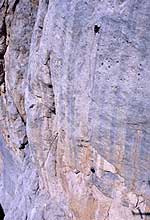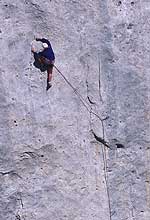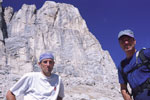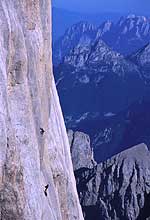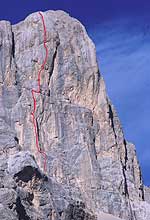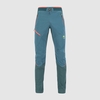| On 12/08/01 Rolando Larcher and Roberto Vigiani redpointed their project of the SW Face of the Marmolada. Named "La LarcherVigiani", it was first ascended in summer 2000 over a four-day period from the ground-up, using aid only to place the bolts on lead.
A century has passed since the historical first ascent of the South Face and theirs is the first route to be opened entirely in this style. It climbs an incredible line up the edge of the Cristina pillar to then continue through the center of the Lindo Pillar.
The first ascentionists’ comments display their enthusiasm, for Rolando states: “excellent rock, in some sections absolutely outstanding”. Roberto adds, “after Hotel Supramonte at Gorropu and this route on the Marmolada, it’s going to be difficult to open a better route”. Unlike the other climbs on the South Face, the LarcherVigiani follows a series of steep slabs and overhanging bulges up pumpy moves on dream-like, rough pocketed limestone.
The SW Face has been the scene of some of the most illustrious ascents in the Dolomites at the hands of Bettega, Zagonel (1901) Soldà (1936), Messner (1969), and Maffei (1982), and this new route is destined to mark the start of a new era. The route is extremely difficult and, apart from the first two pitches and the seventh (which contains a 7a boulder crux), never descends beneath 7b. Five pitches weigh in at 7c or more, and the eighth pitch is graded 8a. The climbing is characterised by steep walls, at times overhanging, up good pockets on rough rock.
Roberto states: “It was my idea to climb a route on the Marmolada because the SW Face was, and remains, wide open for new routes that don’t interfere with existing, historical lines. Rolando was immediately taken in by this project and our main priority, right from the outset, was not to interfere with established trad routes.
We could only free climb the line by using bolts, which we usually use. There are already many routes on the South Face that have some bolted sections, and given the technical difficulties it would have been extremely hard to use other pro, apart from on a few short sections. But it made no sense tying ourselves, forcefully, to tradition. The route follows an ideal line up pockets that, incredibly, lead through the overhanging bulges to the top of the Pilastro Lindo.
We didn’t want to create anything new or heroic, we simply wanted to climb a great hard route on an alpine face. Compared to the other routes we’ve opened using this style of ascent this is surely different due to its demanding nature. The route is long and in an alpine environment, since it climbs the highest mountain in the Dolomites. Despite being bolt protected, it has some hard sections that, given the number of bolts, are run-out and therefore obligatory”.
Rolando and Roberto gave each pitch a name, some emblematic, such as the tenth “polish” pitch, for it would be totally polished due to the number of repeats were it to be at the crag. The ninth “Dream Pitch” is, according to Rolando, the best pitch he has climbed, ever…
The duo needed 12 hours to redpoint the route on 12 August 2001, an almost unreal day of dry and stable weather that hardly ever occur.
From what I could see, following their progress from the via ferrata and photographing them the next day on the final pitches, the rock isn’t exceptional, it’s something even better…
Andrea Gallo
These photos by Andrea Gallo are part of a new multimedia show entitled "CLIMBERS 2001" comprised of slides and video clips.
"CLIMBERS 2001" will be a report about modern day climbing and alpinism and includes protagonists such as Rolando Larcher, Roberto Vigiani, Bubu Bole, Marzio Nardi, Mauro Calibani, Alberto Gnerro, Anita Manachino, Cristian Core... "CLIMBERS 2001" will be released in autumn 2001 and touchs on subjects including bouldering, Big Wall, Dry Tooling, bolts, pegs and mattresses.
by Andrea Gallo & Marzio Nardi
| | |
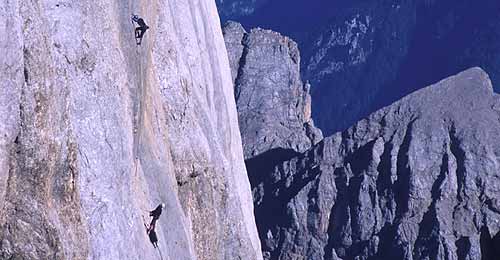



 Copia link
Copia link

